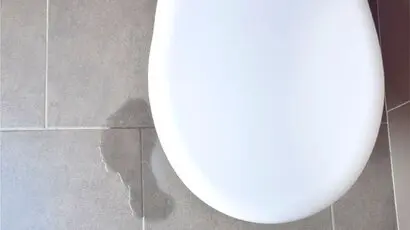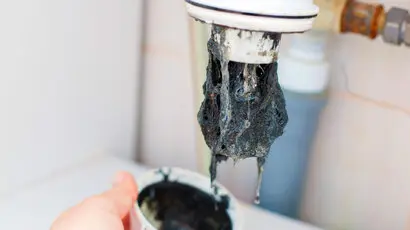How To Clear A Blocked Gutter At Home?
Have you noticed a blockage in your gutters at home? Don’t worry, our guide can help! Grab the gloves and the ladder and follow our simple steps to unclogging your gutter at home!
The gutter system is an indispensable part of your home.
It prevents your roof from overflowing during the rains and keeps the water from damaging your home’s foundation. And trust us; this will save you hundreds of dollars in repair work.
But all this won’t be possible without keeping the gutter system clean and fully functional. Overhanging trees, leaves, and accumulated debris are all culprits of a blocked downpipe or gutter.
And if you’re facing a blocked gutter or blocked downpipe, then let us tell you that cleaning your gutters the DIY way may solve your plumbing problems!
So, jump in to read all about it!

Put the extension ladder safely against the roof, making sure it’s not stretched out too much. Double-check that everything is tight, and it’s always a good idea to have someone hold the ladder while you’re working.
Once you have access to the gutter, take a quick look to determine the type of debris accumulated, as it will help you decide on the cleaning method.
If you spot a lot of wet stuff, you’ll likely need to try either the “scoop and drop” or the “gutter bucket” method to clear it out.
The former is one of the easiest and fastest ways to clean clogged gutters. Start by placing a long and adequately wide piece of fabric (drop cloth) or plastic tarp on the ground, right underneath where you will be cleaning.
Then, use the leaf scooper to drag all the debris and let it fall on the cloth or tarp below. Since the leaves will be wet, you don’t have to worry about them blowing away with the wind.
When the tarp or drop cloth gets full, dump the content into the trash or a compost bin (if you have one) and continue the process until the gutter is free of the wet debris.
You may have to move the ladder several times to access the different areas of the roof gutter. But it’s safer than stretching too much on the ladder and increasing your risk of tipping over.
If you don’t have a tarp or drop cloth handy and don’t fancy a trip to the store, here’s a neat little DIY trick for you.
Take a plastic bucket and cut its handle right in the centre. Slowly bend the halves to transform them into a hook-like shape, which can hang the bucket at the gutter edge.
This will act as a tarp or drop cloth, and you can easily catch the debris. However, one drawback of this method is that the bucket will fill up faster, so you may have to make multiple rounds up and down the ladder to clean the gutters.
Cleaning dry leaves and other dirt from the gutter is challenging, as you must be wary of the weather. After all, the last thing you’d want is for gutter debris to get all over the place!
You can choose to use the bucket from the previous step, or you might cut its bottom out. Attach a gutter bag to it with duct tape or a velcro strap to ensure no part of the bag sticks out or spills over.
Scoop the debris and direct it towards this container, but ensure the weight isn’t too much. Otherwise, the bag may come undone, spreading the contents everywhere on the ground.
Once you’ve finished with the gutter, shift focus to the downpipes. If there are horizontal extension pipes, remove them and place the garden hose at the top connection point of the gutters. Turn on the water, or have someone do it for you, to check how the water runs through.
There’s a clog somewhere if the water doesn’t come out fully. In this case, the full force of the water is used to break the clog and then test again. Use the plumber’s snake if the clog hasn’t cleared out.
Insert it as much as possible and slowly rotate the handle to uncoil the head. The clog will invariably offer resistance to the snakehead, making it difficult for you to operate the handle. So, take your time with this step.
Keep doing this until you can rotate the handle without any significant obstruction. We’d also suggest employing the water test to confirm that the clog, at least most of it, has broken down and been disposed of with the water flow.
Don’t forget to check the extension pipes for clogs and clean them well. Put everything back and test the water flow one last time. Keep the water running for a few minutes to rinse the interiors thoroughly.
Cleaning that nasty gutter or blocked downpipes at home isn’t difficult now.
Once your system is clear and water is flowing nicely, consider adding gutter guards or screens to keep leaves and debris out. While you’re at it, inspect your roof gutters and downpipes for any damage. If you spot issues like cracks or leaks, it’s best to repair them right away.
If you aren’t familiar with a plumber’s snake, practice using it inside a discarded pipe or watch an online tutorial. You can also try cleaning gutters with a gutter vacuum. However, not everyone has one of these devices handed in. But if the debris doesn’t come off with a scoop or the clog doesn’t break even after employing the plumbing snake, it’s best to seek professional help. If you are in Melbourne, WP Plumbing is your local and trusted professional. You can speak with us for any gutter-related issues or maintenance.
We will now leave you to it with our best wishes! We hope you enjoyed our guide on how to clean gutters!
Just found out that your toilet is leaking from the base? Please don’t waste any more time and check out this guide to know the reason behind the leak and how to fix it.
Blocked drains are a common plumbing problem that property owners have to deal with. Here, we are looking at one of the most common ones: Read Now.
Learn where drain clogs commonly occur in homes, like sinks, showers, toilets, and sewer lines. Discover what causes blockages from hair, grease, tree roots, and more. Get tips to prevent clogged drains and when to call a plumber to clear obstructions.


